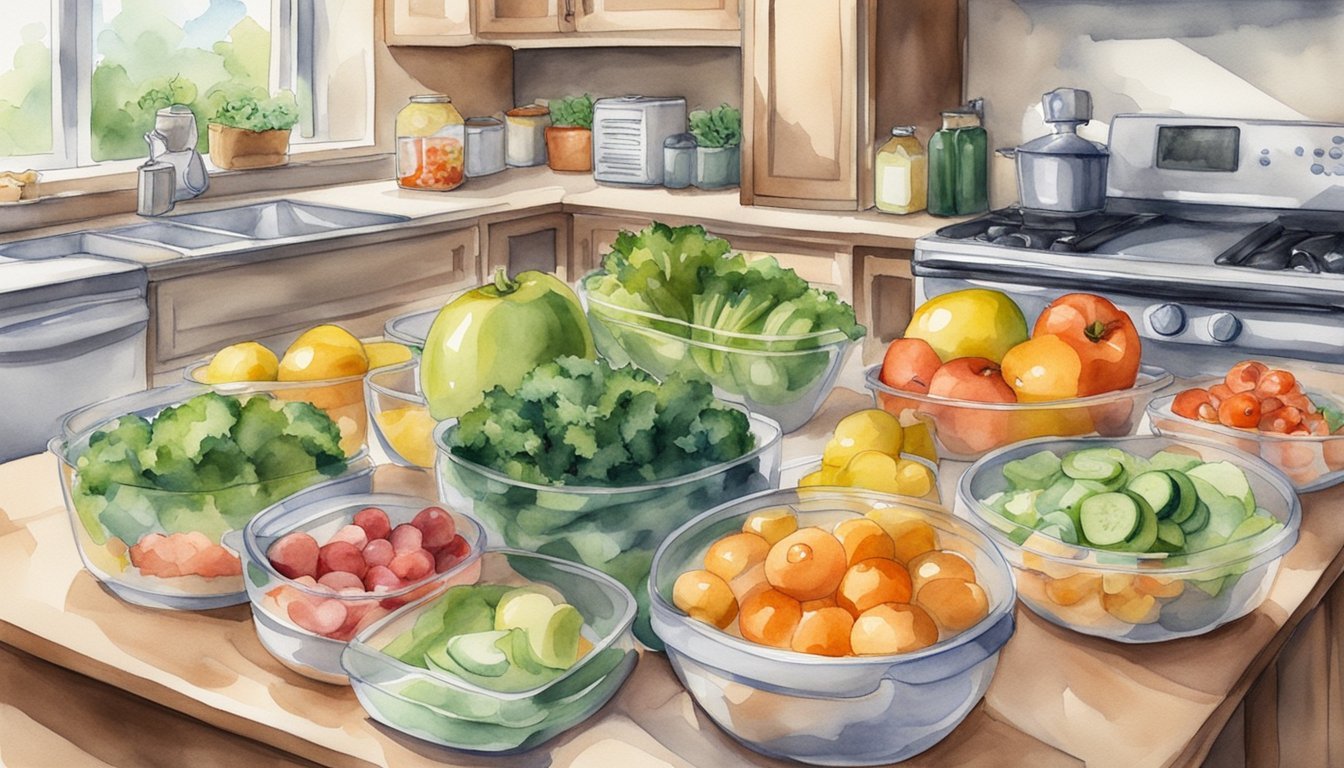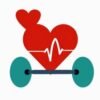7 Time-Saving Meal Prep Hacks for Busy Fitness Enthusiasts: Fuel Your Workouts Faster

Are you tired of spending hours in the kitchen after a long workout? We’ve got you covered! Meal prepping is the secret weapon of busy fitness fans.
It helps you stay on track with your goals while saving time and money.

These 7 time-saving meal prep hacks will change your life. You’ll learn how to make tasty, healthy meals in a snap.
Get ready to take your fitness game to the next level without breaking a sweat in the kitchen.
1) Prepare Overnight Oats
Overnight oats are a game-changer for busy fitness enthusiasts.
They’re quick, easy, and packed with nutrients to fuel your workouts.
To make them, simply mix oats, milk, yogurt, and your favorite toppings in a jar before bed.
In the morning, you’ll have a delicious breakfast ready to go.
You can prep several jars at once for the whole week.
This saves precious time during hectic mornings.
Customize your oats with protein powder, fruit, or nuts to match your fitness goals.
For a protein boost, try adding chia seeds or hemp hearts.
These tiny powerhouses are packed with nutrients.
Overnight oats are versatile too.
Eat them cold straight from the fridge, or warm them up if you prefer.
They’re perfect for post-workout recovery or a quick pre-gym snack.
Don’t forget to experiment with flavors.
Try cinnamon, vanilla, or cocoa powder for variety.
You can even add a scoop of your favorite protein powder for an extra nutrition boost.
With overnight oats, you’ll never skip breakfast again.
They’re a simple solution for busy mornings that keeps you on track with your fitness goals.
2) Chop Vegetables in Bulk

Chopping vegetables in bulk is a game-changer for busy fitness enthusiasts.
This simple hack can save you tons of time during the week.
Set aside an hour on the weekend to prep all your veggies at once.
Start by washing and drying your vegetables thoroughly.
Then, chop them into the sizes you’ll need for your meals.
Store each type in separate airtight containers in the fridge.
Pre-chopped veggies make it easy to throw together quick stir-fries, salads, or snacks.
You’ll be more likely to eat healthy when the hard work is already done.
Consider prepping a variety of vegetables.
Onions, peppers, carrots, and celery are versatile options.
Don’t forget about leafy greens like kale or spinach.
You can also roast a big batch of veggies at once.
This gives you ready-to-eat sides or ingredients for other dishes.
Roasted veggies are great for adding to salads, grain bowls, or wraps.
Remember to use your prepped veggies within 3-5 days for best quality and freshness.
This method not only saves time but also reduces food waste.
3) Use Pre-cooked Grains
Pre-cooked grains can save you lots of time when meal prepping.
You can find them in most grocery stores, ready to heat and eat.
Brown rice, quinoa, and barley are great options.
They’re packed with nutrients and fiber to keep you full.
Add pre-cooked grains to salads, soups, or stir-fries.
They make a quick base for grain bowls topped with veggies and protein.
Keep a few packs in your pantry.
You can quickly make a meal when you’re short on time.
Mix pre-cooked grains with roasted veggies and dressing.
This makes an easy side dish or lunch.
You can also use them in breakfast dishes.
Try adding to yogurt with fruit for a filling morning meal.
Pre-cooked grains stay fresh in the fridge for several days.
Cook a big batch on Sunday to use all week.
Remember to check the label.
Some brands add extra salt or preservatives.
Choose plain varieties when possible.
4) Cook Protein in Advance
Cooking protein ahead of time can save you loads of time during busy weeks.
Pick a day to prep several portions of chicken, fish, or tofu.
You can grill, bake, or poach these in batches.
Store cooked protein in airtight containers in the fridge.
This way, you’ll have ready-to-eat protein for quick meals throughout the week.
Try cooking chicken breasts with different seasonings.
This adds variety to your meals without extra prep time.
You can easily shred cooked chicken for salads, wraps, or stir-fries.
Hard-boiled eggs are another great protein option.
Cook a dozen at once and keep them in the shell.
They’ll stay fresh in the fridge for up to a week.
For plant-based protein, cook a big batch of lentils or beans.
These can be added to salads, soups, or grain bowls for quick, high-protein meals.
Don’t forget about canned options like tuna or salmon.
These require no cooking and can be mixed with veggies for a fast meal.
By having protein ready to go, you’ll save time and stay on track with your fitness goals.
It’s much easier to eat well when healthy options are already prepared.
5) Make Smoothie Packs
Smoothie packs are a great way to save time in the morning.
You can prepare them in advance and have a quick, healthy breakfast ready to blend.
To make smoothie packs, start by choosing your favorite fruits and veggies.
Chop them into small pieces and measure out single-serving portions.
Put each portion in a freezer-safe bag or container.
Add some protein to your packs for extra nutrition.
Good options include Greek yogurt, protein powder, or nut butter.
Don’t forget to include some greens like spinach or kale.
They blend well and add important nutrients to your smoothie.
You can also add extras like chia seeds, flax seeds, or coconut flakes for more flavor and nutrients.
Just be sure to keep these separate from the frozen items.
When you’re ready to make your smoothie, simply empty a pack into your blender.
Add some liquid like milk or juice, then blend until smooth.
By prepping your smoothie ingredients ahead of time, you’ll have a nutritious breakfast ready in minutes.
This can help you stick to your fitness goals even on busy mornings.
6) Freeze Single Portions

Freezing single portions is a game-changer for busy fitness enthusiasts.
This hack saves time and ensures you always have a healthy meal ready.
Start by cooking larger batches of your favorite meals.
Once cooled, divide them into individual containers.
Use microwave-safe, freezer-friendly containers for easy reheating.
Label each container with the meal name and date.
This helps you keep track of what’s in your freezer and when it was made.
Aim to use frozen meals within 2-3 months for best quality.
When you’re ready to eat, simply grab a container from the freezer.
Thaw it in the fridge overnight or use the microwave for quick defrosting.
You’ll have a homemade meal in minutes.
This method works great for protein-packed dishes like chicken stir-fries, beef stews, or vegetarian chilis.
It’s perfect for those days when you’re too tired to cook but still want a nutritious meal.
Remember to include a variety of meals in your freezer stash.
This prevents boredom and ensures you’re getting diverse nutrients.
Try freezing soups, casseroles, and even breakfast items like protein pancakes.
By freezing single portions, you’ll always have a healthy option on hand.
This can help you stick to your fitness goals and avoid unhealthy takeout temptations.
7) Utilize a Slow Cooker
A slow cooker is a fitness enthusiast’s best friend for easy meal prep.
You can toss in ingredients before work and come home to a ready-made meal.
Slow cookers are great for making large batches of food.
This lets you prepare multiple meals at once, saving time throughout the week.
Try making protein-packed dishes like chicken breast or lean beef stew.
These provide the nutrients you need to fuel your workouts.
Vegetables cook well in slow cookers too.
Add a variety of colorful veggies to boost your meal’s nutritional value.
Healthy slow cooker recipes are easy to find online.
Look for options that fit your dietary needs and fitness goals.
You can prep ingredients the night before.
In the morning, just put everything in the slow cooker and turn it on.
When you get home, your meal will be ready.
This saves you from having to cook when you’re tired after a long day and workout.
Slow cookers are versatile.
You can make soups, stews, chili, and even some desserts.
This variety keeps your meal prep interesting.
Clean-up is simple with a slow cooker.
Many have removable pots that are dishwasher safe.
This means less time cleaning and more time for your fitness routine.
Benefits of Meal Prep for Fitness Enthusiasts

Meal prep offers key advantages for those focused on fitness.
It helps you eat better and saves precious time in your busy schedule.
Enhanced Nutrient Intake
Meal prep allows you to plan balanced meals with the right mix of nutrients.
You can choose healthier ingredients and control portion sizes.
This makes it easier to meet your fitness goals.
By prepping meals, you avoid last-minute unhealthy choices.
You’ll have nutritious options ready when you’re hungry after a workout.
This helps you stick to your diet plan.
Meal prep also lets you track your macros more easily.
You can measure proteins, carbs, and fats for each meal.
This precision is key for muscle building and weight management.
Time Efficiency
Meal prep saves you lots of time during the week.
You can cook in bulk on weekends or less busy days.
Then you’ll have ready-to-eat meals for busy weekdays.
This cuts down on daily cooking and cleanup time.
You won’t need to figure out what to eat for each meal.
Everything is planned and prepared in advance.
Meal prep also reduces grocery store trips.
You can buy ingredients in bulk for the week.
This saves time and often money too.
Having meals ready can give you more time for workouts.
You won’t need to rush home to cook after the gym.
This can help you stay consistent with your fitness routine.
Key Components of a Balanced Meal Prep Plan
A balanced meal prep plan focuses on providing the right mix of nutrients and variety to fuel your fitness goals.
It’s about creating meals that are both nutritious and enjoyable to eat throughout the week.
Macronutrient Distribution
When planning your meals, aim for a good balance of proteins, carbohydrates, and fats.
Protein is crucial for muscle repair and growth.
Include lean meats, fish, eggs, or plant-based options like beans and tofu in your prep.
Carbs provide energy for workouts.
Choose whole grains, sweet potatoes, and fruits.
Healthy fats from nuts, seeds, and avocados help with hormone production and nutrient absorption.
A good starting point is to fill 1/3 of your plate with protein, 1/3 with complex carbs, and 1/3 with veggies.
Adjust based on your specific fitness goals and body needs.
Incorporating Variety
Eating the same meals every day can get boring fast.
Mix things up to keep your taste buds happy and ensure you’re getting a wide range of nutrients.
Try prepping different protein sources each week.
One week chicken, the next fish or tofu.
Rotate your veggies and grains too.
This meal variety strategy can help you stick to your plan long-term.
Use herbs and spices to create different flavors without adding extra calories.
Greek seasoning one day, Mexican spices the next.
This keeps meals interesting without extra prep work.
Tips for Successful Meal Prep
Meal prepping can save you time and help you stick to your fitness goals.
These tips will make your meal prep process smoother and more efficient.
Batch Cooking Techniques
Batch cooking is a great way to save time.
Cook large amounts of protein like chicken or beef at once.
You can use a slow cooker or instant pot to make this easier.
Roast several trays of vegetables at the same time.
Make big batches of grains like rice or quinoa.
These can be the base for many meals.
Cook soups or stews in large quantities.
They freeze well and are easy to reheat.
Use assembly line methods.
Prepare all ingredients first, then put together multiple meals at once.
This is faster than making each meal separately.
Storing and Reheating Meals
Use good quality containers for storage.
Glass containers are durable and don’t absorb smells or stains.
Divide meals into individual portions for easy grabbing.
Label containers with contents and dates.
This helps you keep track of what you have and when it was made.
Store meals properly in the fridge or freezer to maintain freshness.
When reheating, add a splash of water to grains or vegetables.
This prevents drying out.
Use the microwave for quick reheating, or the oven for crispier results.
Let frozen meals thaw in the fridge overnight before reheating.
This ensures even heating.
Stir food halfway through reheating for better temperature distribution.
Frequently Asked Questions
Meal prepping can save time and help you stick to your fitness goals.
These common questions address key strategies for efficient and effective meal preparation.
How can I efficiently meal prep for a week’s worth of healthy food?
Plan your meals in advance.
Focus on versatile ingredients that can be used in multiple dishes. Prepare large batches of staples like grains, proteins, and chopped vegetables.
Use portion-sized containers to divide meals.
This makes grabbing food throughout the week quick and easy.
What are the essential steps for quick and effective meal preparation?
Start by planning your menu and making a grocery list.
Prep ingredients in bulk, like chopping vegetables for several meals at once.
Cook proteins and grains in large batches.
Assemble meals in containers for easy grab-and-go options during the week.
What kitchen tools do I need to streamline my meal prepping process?
Invest in good quality food storage containers.
A sharp chef’s knife and cutting board are essential for efficient chopping.
A slow cooker or Instant Pot can help cook large batches of food with minimal effort.
A food scale is useful for portion control.
How do I balance variety and simplicity in my meal prep routine?
Choose a few base ingredients that can be mixed and matched.
For example, cook chicken that can be used in salads, wraps, or stir-fries.
Vary your sauces and seasonings to create different flavors with the same ingredients.
This adds variety without extra prep work.
What strategies can I use to meal prep if I have limited time on the weekends?
Break your prep into smaller sessions throughout the week.
Chop vegetables one day, cook proteins another.
Use shortcuts like pre-cut vegetables or rotisserie chicken.
Make overnight oats for quick, no-cook breakfasts.
How can I maintain freshness in my meals when prepping for several days?
Store ingredients separately and assemble just before eating when possible.
This works well for salads and wraps.
Freeze portions you won’t eat within 3-4 days.
Use airtight containers to keep food fresh longer in the refrigerator.






